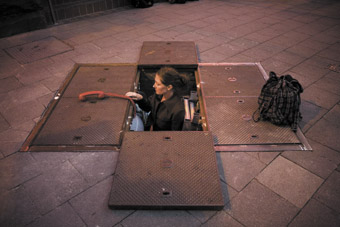out of the underworld
sue moss witnesses lucy wilson’s ascent

Lucy Wilson, Underwhere
photo Peter Mathew
Lucy Wilson, Underwhere
A WOMAN APPEARS ON A STREET CORNER IN THE MIDDLE OF THE HOBART CBD. SHE STANDS NEAR THE BUS MALL. BENEATH A BROWN TRENCH COAT, SHE WEARS TROUSERS AND A YELLOW VEST TRIMMED WITH FLUORO SAFETY TAPE THAT SWINGS AND FLASHES. IT IS 8.30 PM AND LUCY WILSON’S PERFORMANCE AND VISUAL INSTALLATION SITUATED AROUND A MANHOLE COMMENCES.
“Don’t talk to strangers”, her mother said, stepping off the curb and under a bus. Longing for reconnection with her lost mother’s voice becomes the imperative for Wilson’s journey.
She stands on the manhole cover wrought in a recurring pattern. Her soles seem imprinted with a grid motif which works as a shadow overlay to her mind’s incessant question of who is responsible for her mother’s death. Wilson frequently confronts her unresolved grief through introspection and blame.
She lifts the cast iron manhole lid and descends into the underworld. Joey Ruigrok van der Werven’s set design taunts with a blaze of light revealing an underground network of cables, pipes, and tunnels. We peer in, fascinated with this revelation. Above ground, interconnecting roads, footpaths, dreams, desires and loss impress our shoe soles like ley lines—the intersection of Wilson’s quest with our own.
Red, yellow, black and white phones appear and are placed like compass points around the manhole pit. The phones ring. Cradling each in turn, the performer listens and redials. Her desire for connection with the irretrievable rings out to silence.
A ladder emerges guided by pale arms. Piece by piece the extensions snap-lock into place ascending toward the sky. Wilson climbs from her pit of despair with a radiant orb of light snaking from her body. The silver ladder becomes a locale for reclamation of ordinary acts as she cleans her fragile world. Underwear is draped across the ladder, fingernails are shaped, a light is switched on, a tap buffed.
Wilson produces a silver kettle, a heating ring and a plumbing line complete with tap. A piano mood-scape tinkles and light refracts from shiny surfaces and safety gaffer tape. She makes a cup of tea, then sips—a homage under lamplight. Her slow deliberate drinking is a re-enactment of her last treasured memory, sharing tea with her mother.
Above our heads an advertising sign reads, “Capture the Spirit”, as Wilson navigates her way through, under and over worlds, seeking, searching, and trying to link with her lost mother. Tik-tokking traffic lights and frenetic ‘safe to walk’ pitches are amplified and echo through Matthew Dewey’s sound score.
Finally the phone is answered offering communication with an ethereal world and, for the performer, redemption. She draws a tear-shaped crystal from her mouth. This crystallisation of sorrow enables Wilson to resolve her loss and to relinquish her constant questioning.
Peering into the crevasse of both street and self, Lucy Wilson’s strong performance offers a portal to hidden worlds. It is the journey of a woman seeking connection through the interstices of self, a street corner, a manhole and a city.
Lucy Who Productions, Underwhere, performer Lucy Wilson, director Robert Jarman, writer Willoh S Welland, composition and sound design Matthew Dewey, costume design Hanna Pärssinen, set construction, design Joey Ruigrok van der Werven, prop design, construction Bruce Hay; CBD, Hobart February 15-17, 22-24
RealTime issue #78 April-May 2007 pg. 36






